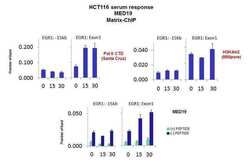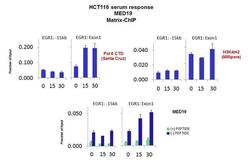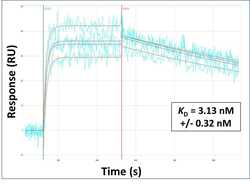Antibody data
- Antibody Data
- Antigen structure
- References [1]
- Comments [0]
- Validations
- Chromatin Immunoprecipitation [2]
- Other assay [1]
Submit
Validation data
Reference
Comment
Report error
- Product number
- PA5-44383 - Provider product page

- Provider
- Invitrogen Antibodies
- Product name
- MED19 Polyclonal Antibody
- Antibody type
- Polyclonal
- Antigen
- Synthetic peptide
- Description
- Peptide sequence: LPGSHDNSSL RSLIEKPPIL SSSFNPITGT MLAGFRLHTG PLPEQCRLMH Sequence homology: Cow: 100%; Dog: 100%; Guinea Pig: 100%; Horse: 100%; Human: 100%; Mouse: 100%; Rabbit: 100%; Rat: 100%; Zebrafish: 92%
- Reactivity
- Human
- Host
- Rabbit
- Isotype
- IgG
- Vial size
- 100 μL
- Concentration
- 0.5 mg/mL
- Storage
- -20°C, Avoid Freeze/Thaw Cycles
Submitted references MED19 Regulates Adipogenesis and Maintenance of White Adipose Tissue Mass by Mediating PPARγ-Dependent Gene Expression.
Dean JM, He A, Tan M, Wang J, Lu D, Razani B, Lodhi IJ
Cell reports 2020 Oct 6;33(1):108228
Cell reports 2020 Oct 6;33(1):108228
No comments: Submit comment
Supportive validation
- Submitted by
- Invitrogen Antibodies (provider)
- Main image

- Experimental details
- ChIP assay analysis of quiescent human colon carcinoma HCT116 cells using an anti-MED19 polyclonal antibody (Product # PA5-44383).
- Submitted by
- Invitrogen Antibodies (provider)
- Main image

- Experimental details
- ChIP assay analysis of quiescent human colon carcinoma HCT116 cells using an anti-MED19 polyclonal antibody (Product # PA5-44383).
Supportive validation
- Submitted by
- Invitrogen Antibodies (provider)
- Main image

- Experimental details
- Surface Plasmon Resonance of MED19 polyclonal antibody (Product # PA5-44383). Purified polyclonal antibodies were immobilized on a Protein A/G coated Carterra LSA sensor chip at concentrations of 5, and 50 µg/mL in duplicate. Antibodies on the surface were exposed to interaction with peptides sequentially via microfluidic controlled flow at 333 nm peptide concentration for kinetic characterization of the binders for affinity and specificity, followed by curve fitting using the Kinetics software. Kd determinations for both concentrations were averaged and results and standard deviation are shown.
 Explore
Explore Validate
Validate Learn
Learn Western blot
Western blot Chromatin Immunoprecipitation
Chromatin Immunoprecipitation